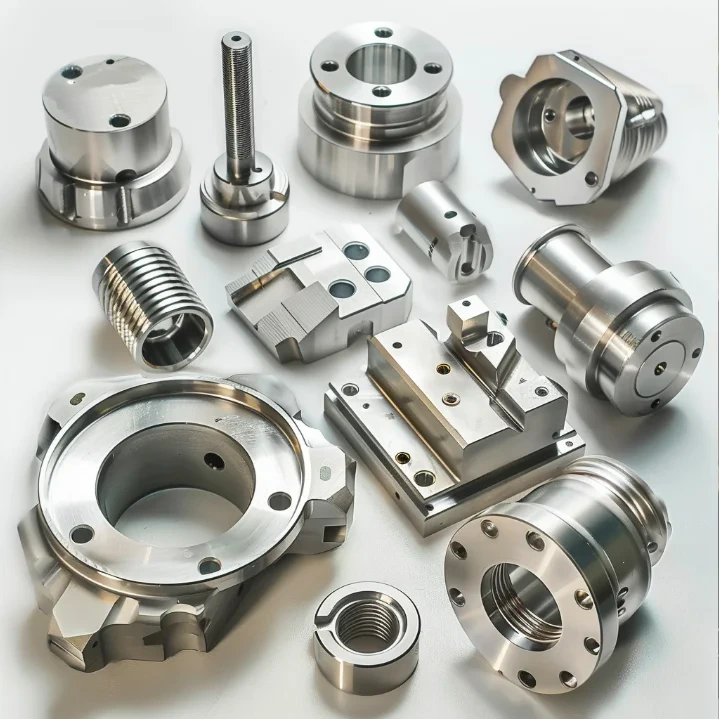Advanced Techniques for Machining Stainless Steel Alloys

I. Introduction: Navigating the Challenges of Stainless Steel
Stainless steel alloys are indispensable in industries ranging from aerospace to medical devices due to their superior corrosion resistance, high strength, and aesthetic appeal. However, these very properties present significant hurdles during machining. The core challenges are well-documented: severe work-hardening, which rapidly dulls cutting edges; low thermal conductivity, leading to intense heat concentration at the tool-workpiece interface; and the tendency to form long, stringy chips, complicating material removal.
Effectively machining these alloys—particularly the high-toughness austenitic (300 series) and the challenging duplex grades—requires moving beyond conventional methods and adopting advanced, integrated strategies across material, tooling, and process control.
II. Tooling and Insert Technology: The Foundation of Success (Section IV)
The selection of cutting tools is the most critical factor in overcoming stainless steel’s work-hardening tendency. Advanced techniques rely on specialized inserts designed to minimize friction and dissipate heat efficiently.
Optimized Materials and Geometries
- Carbide Grades: Precision machining requires fine-grain carbides with a careful balance of high toughness and wear resistance. These tools are engineered to withstand the high cutting forces and elevated temperatures.
- Tool Geometry: A key advanced strategy is the use of sharp edges and high positive rake angles. A positive rake angle helps to shear the material rather than push it, reducing cutting forces and minimizing the formation of the hardened layer.
- Advanced Coatings: Physical Vapor Deposition (PVD) coatings, such as Titanium Aluminum Nitride (TiAlN) or Aluminum Titanium Nitride (AlTiN), are critical. These multi-layer coatings provide high hot-hardness and oxidation resistance, acting as a thermal barrier that shunts heat away from the carbide substrate.
III. Advanced Coolant and Lubrication Strategies (Section III)
Heat management is paramount. While traditional flood coolants often fail to penetrate the cutting zone effectively, advanced techniques deploy pressurized and temperature-controlled fluids to control heat and fracture chips.
High-Pressure and Cryogenic Solutions
- High-Pressure Coolant (HPC): Delivering coolant at pressures often exceeding 1,000 psi (70 bar) is highly effective. The forceful jet hydraulically wedges itself between the chip and the tool face, promoting chip fracture and providing superior cooling, which can dramatically increase tool life and permit higher cutting speeds.
- Cryogenic Machining: Techniques using liquid nitrogen (LN₂) or carbon dioxide (CO₂) to cool the cutting zone to sub-zero temperatures represent a significant leap. This approach improves the material’s shear strength and rigidity, reducing the tendency to form a problematic built-up edge (BUE) and enhancing surface integrity.
- Minimum Quantity Lubrication (MQL): By atomizing a small volume of high-performance oil into a stream of compressed air, MQL provides lubrication right at the point of contact. This nearly-dry process reduces fluid disposal costs while offering better thermal stability than flood cooling.
IV. Optimized Machining Parameters and Process Control (Section V)
Advanced process control focuses on continuous tool engagement and precise path planning to avoid the detrimental effects of rubbing or dwell time, which immediately induces work-hardening.
Dynamic Machining Strategies
- Constant Engagement: A foundational rule is to ensure the tool is always actively cutting. Pauses or very light cuts cause the tool to rub against the material, creating a hardened surface layer that makes the next cut impossible without significant wear.
- Trochoidal Milling: This technique, where the tool moves in a continuous circular path, is highly effective for deep slots. It ensures a consistent, low width of cut and a constantly varying point of engagement, distributing thermal and mechanical stress across the entire cutting edge, thereby maximizing tool life.
- High Feed, Moderate Speed: Often, increasing the feed rate is preferred over increasing the cutting speed. A higher feed rate ensures the tool gets beneath the previously work-hardened layer quickly, while moderate speeds help manage the generated heat.
V. Post-Machining Integrity and Preparation (Section VI)
The final stages involve ensuring both dimensional accuracy and chemical integrity. Once the parts have undergone precision CNC machining, the surface must be prepared for its intended operating environment. This includes:
- Deburring: High-speed deburring or abrasive flow machining to remove burrs without compromising the surface finish.
- Passivation: A chemical treatment (typically a nitric or citric acid bath) is essential to remove any “free iron” particles embedded during the machining process and restore the material’s inherent corrosion resistance by reforming the protective chromium oxide layer.
VI. Data Parameters: Example Cutting Conditions
The following table illustrates sample advanced cutting parameters for turning common stainless steel alloys, emphasizing the need for application-specific optimization.
| Stainless Steel Grade | Condition/Type | Tool Material | Cutting Speed (Vc) [m/min] | Feed Rate (f) [mm/rev] | Depth of Cut (ap) [mm] | Primary Challenge |
| 304 (Austenitic) | Solution Annealed | PVD-TiAlN Coated Carbide | 120 – 180 | 0.25 – 0.40 | 1.5 – 3.0 | Work Hardening, Chip Control |
| 316L (Austenitic) | Solution Annealed | CVD-Coated Carbide | 100 – 150 | 0.20 – 0.35 | 1.0 – 2.5 | Heat Build-up, BUE |
| 420 (Martensitic) | Quenched & Tempered | Ceramic/PCBN | 180 – 250 | 0.15 – 0.25 | 0.5 – 1.5 | Hardness, Abrasive Wear |
| Duplex 2205 | Solution Annealed | Specialized Carbide (High Toughness) | 80 – 120 | 0.30 – 0.45 | 2.0 – 4.0 | High Strength, Difficult Chip |
VII. Conclusion
Machining stainless steel alloys at production scale is an art governed by scientific principles. Success relies on a holistic approach: leveraging tools with advanced coatings and positive geometry, implementing sophisticated heat-management systems like HPC and MQL, and utilizing dynamic path planning.
For companies requiring low-volume manufacturing or high-volume production of custom stainless steel parts that meet stringent quality and tolerance requirements, advanced strategies ensure both cost-effectiveness and part integrity. To learn more about how these precise techniques are applied in the industry, you can explore specialized Precision CNC Machining & Prototyping Services that cater to complex materials like stainless steel. By continuously integrating the latest in tooling and process technology, manufacturers can confidently transform challenging stainless steel stock into high-performance components.
FAQs
Q1: Why is stainless steel notoriously difficult to machine?
Stainless steel is challenging due primarily to severe work-hardening (especially austenitic grades like 304/316), low thermal conductivity (which concentrates heat on the cutting tool), and its tendency to form long, stringy chips that hinder material removal.
Q2: What is the single most important factor for improving tool life?
Effective heat management is critical. Techniques like High-Pressure Coolant (HPC), which removes heat and fractures chips, and specialized PVD-coated carbide inserts that act as thermal barriers, are essential for extending tool life.
Q3: What is “work-hardening” and how is it addressed during machining?
Work-hardening is the process where the metal’s surface rapidly hardens as a result of plastic deformation (rubbing) during cutting. It’s addressed by using sharp tooling with positive rake angles to shear the material cleanly, and by maintaining constant engagement with high feed rates to ensure the tool always cuts beneath the newly hardened layer.
Q4: How do advanced coatings like TiAlN and AlTiN help?
These coatings (e.g., Titanium Aluminum Nitride) are applied via PVD (Physical Vapor Deposition) and provide high hot-hardness and oxidation resistance. They act as a thermal shield, significantly reducing the transfer of intense cutting heat to the carbide substrate, thereby preserving the tool’s sharpness and extending its life.
Q5: What is High-Pressure Coolant (HPC) and how does it improve the process?
HPC involves delivering coolant at pressures often exceeding 1,000 psi (70 bar). The high pressure forces the coolant into the cutting zone and provides a hydraulic wedge that efficiently breaks the chip into small, manageable segments, which dramatically improves evacuation and cooling.
Q6: Is Cryogenic Machining or MQL better for stainless steel?
Cryogenic Machining (using LN₂ or CO₂) is excellent for improving surface integrity and minimizing the Built-Up Edge (BUE) due to extreme cooling. MQL (Minimum Quantity Lubrication) is a more environmentally friendly approach that uses an oil-air mist for focused lubrication, primarily reducing friction and disposal costs. The best choice depends on the specific alloy and application requirements.
Q7: What is Trochoidal Milling and when is it used?
Trochoidal Milling is an advanced milling strategy where the tool moves in a continuous circular path while progressing forward. It is primarily used for deep slotting or pocketing because it ensures a constant, low width of cut, which distributes thermal load evenly and prevents excessive heat build-up.
Q8: Why is “High Feed, Moderate Speed” often the preferred strategy?
This strategy prioritizes using a higher feed rate to quickly penetrate and remove the work-hardened material layer. Moderate cutting speeds are maintained to control the overall heat generated, offering a balance that minimizes work-hardening while managing thermal wear on the tool.
Q9: What post-machining treatment is essential for stainless steel parts?
Passivation is essential. This is a chemical treatment (e.g., with citric or nitric acid) used to remove any microscopic “free iron” particles embedded during machining and chemically reform the protective chromium oxide layer on the surface, ensuring the finished part has maximum corrosion resistance.



